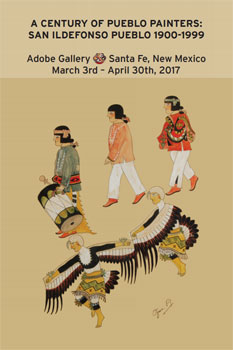Pueblo Village Scene with Eagle Dancers and Drummers Painting by Oqwa Pi - C3874C
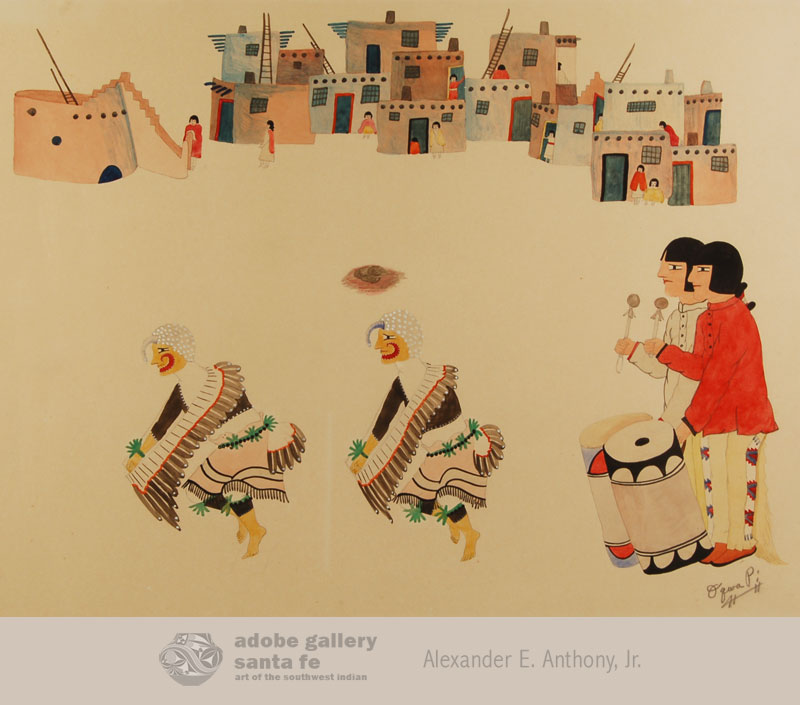 The Eagle Dance is performed in early spring and repeated from time to time during the summer. The eagle is believed to have direct intercourse with sky powers and is venerated by the Pueblo Indians. The Pueblo Eagle Dance is a dramatization of the relationship between the eagle, man, and supernatural forces. During the dance, two young men who are costumed as eagles imitate the movements of actual eagles. They replicate eagles soaring over the fields, perching on high places, and resting on the ground.
The Eagle Dance is performed in early spring and repeated from time to time during the summer. The eagle is believed to have direct intercourse with sky powers and is venerated by the Pueblo Indians. The Pueblo Eagle Dance is a dramatization of the relationship between the eagle, man, and supernatural forces. During the dance, two young men who are costumed as eagles imitate the movements of actual eagles. They replicate eagles soaring over the fields, perching on high places, and resting on the ground.
Abel Sanchez (1899-1971) Oqwa Pi - Kachina Stick has provided us with a good interpretation of two young men performing the Eagle Dance, accompanied by two drummers. In the background we see a kiva with houses nearby.
San Ildefonso Pueblo Painting of Goat Herder with Goats by Alfonso Roybal - C3874J
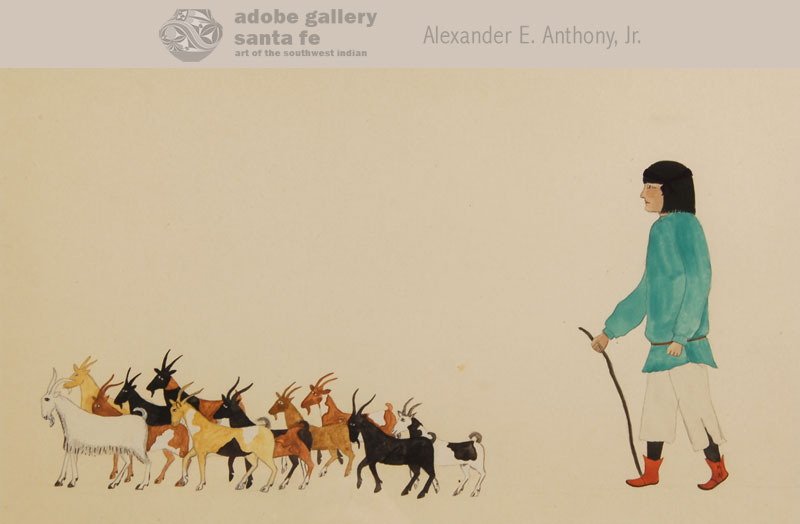 Most pueblo artist's paintings, especially the early students of The Studio of the Santa Fe Indian School, dwell on ceremonial items or individual dancers. That is what Esther Hoyt, the San Ildefonso Day School teacher from 1900 to 1907 encouraged them to do. It is also what Dorothy Dunn, the teacher at The Studio, encouraged of her students in the 1930s.
Most pueblo artist's paintings, especially the early students of The Studio of the Santa Fe Indian School, dwell on ceremonial items or individual dancers. That is what Esther Hoyt, the San Ildefonso Day School teacher from 1900 to 1907 encouraged them to do. It is also what Dorothy Dunn, the teacher at The Studio, encouraged of her students in the 1930s.
Awa Tsireh has provided a refreshing image of a daily ritual-a young man herding his goats along. In typical fashion of The Studio style of presentation, there is no ground plane, no plants, and nothing in the sky. All we see are goats and the herder.
A CENTURY OF PUEBLO PAINTERS: SAN ILDEFONSO PUEBLO 1900—1999, Special Exhibit
You can download the digital version of our catalog!
On Friday, March 3, 2017, Adobe Gallery's "A Century of San Ildefonso Painters: 1900-1999" opens with a reception at 221 Canyon Road from 5-7 pm. The show, which will continue through the end of April, will feature over 50 paintings from a wide variety of artists from San Ildefonso Pueblo.
A large portion of these paintings come from the Charlotte Greenleaf Mittler Collection, which was displayed in a successful and well-regarded 2009 exhibit at the Wheelwright Museum of the American Indian. The exhibit at Adobe Gallery will be a must-see for anyone who is interested in Pueblo Indian art, as it will provide a comprehensive look at the works of the first Pueblo painters and the evolution of the style they created.
Large Red Sgraffito Carved Santa Clara Jar by Joseph Lonewolf - C3879
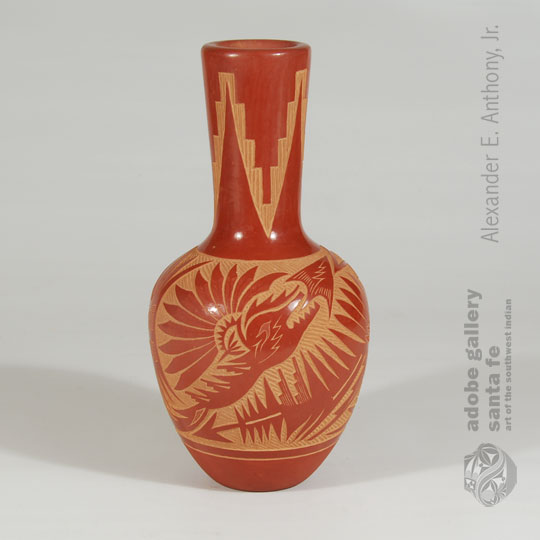 Joseph Lonewolf started a career as a mechanic and then became a trained machinist, making precision parts with fine engraving. It was this skill that he used to transfer his talent from mechanical objects to precision-carved pottery. In 1971, Lonewolf returned to Santa Clara Pueblo and put his skills to making pottery as had been taught to him by his mother, Agapita Silva Tafoya. His father, Camilio Tafoya, had taken him as a child into the mountains where he witnessed petroglyphs carved into caves and on walls of cliffs. Lonewolf took the lessons of his mother and field trips with his father and combined the two to arrive at intricately-carved designs on pottery.
Joseph Lonewolf started a career as a mechanic and then became a trained machinist, making precision parts with fine engraving. It was this skill that he used to transfer his talent from mechanical objects to precision-carved pottery. In 1971, Lonewolf returned to Santa Clara Pueblo and put his skills to making pottery as had been taught to him by his mother, Agapita Silva Tafoya. His father, Camilio Tafoya, had taken him as a child into the mountains where he witnessed petroglyphs carved into caves and on walls of cliffs. Lonewolf took the lessons of his mother and field trips with his father and combined the two to arrive at intricately-carved designs on pottery.
Original Fred Harvey Company Style Navajo Ring with Arrows - C3864.39
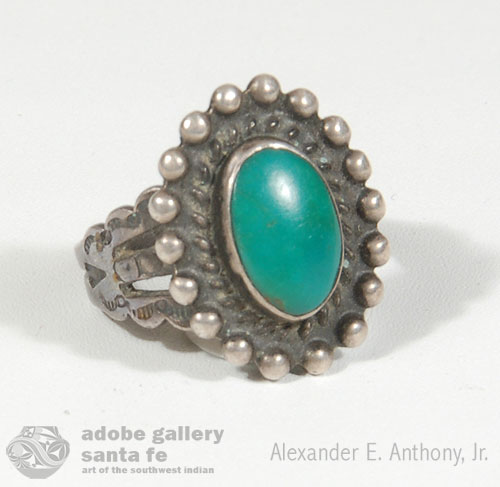 The Fred Harvey Company built hotels along the rail line from the mid-West to the California coast from the late 1800s when trains were traveling daily from Kansas to California and return. In many of these hotels, particularly at the Alvarado Hotel in Albuquerque, the Company had gift shops featuring arts and crafts of Native American tribes. Jewelry made by native craftsmen were particularly popular with train travelers. Jewelry with silver and turquoise was not known outside the Southwest so it made a particularly unique souvenir to take back home.
The Fred Harvey Company built hotels along the rail line from the mid-West to the California coast from the late 1800s when trains were traveling daily from Kansas to California and return. In many of these hotels, particularly at the Alvarado Hotel in Albuquerque, the Company had gift shops featuring arts and crafts of Native American tribes. Jewelry made by native craftsmen were particularly popular with train travelers. Jewelry with silver and turquoise was not known outside the Southwest so it made a particularly unique souvenir to take back home.
Pyramidal Stacked Silver and Turquoise Navajo Ring - C3864.34
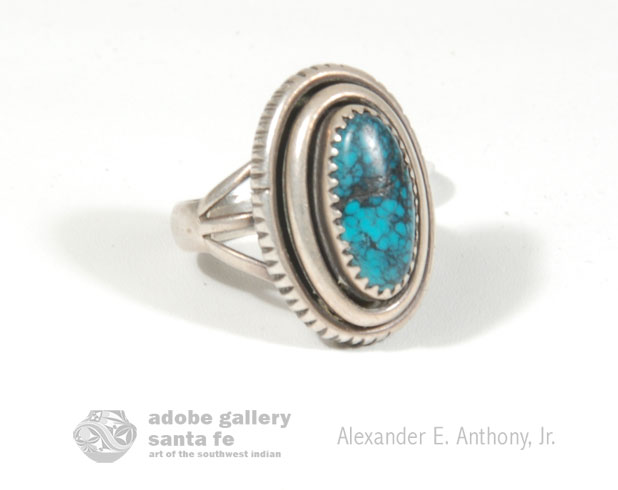 This magnificent blue turquoise cab has a fracture across the center at the point where there is a dark spot. The stone, however, is securely anchored in the silver bezel. The turquoise sits atop layers of silver. The lowest layer is the widest and is scored around its edges with lines. The next upper layer is a smooth silver pedestal. The upper layer is the turquoise cab in its bezel. Each layer is smaller than the preceding one, making a pyramidal shape. The silver band is divided into three branches at the base of the Pyramidal Stacked Silver and Turquoise Navajo Ring.
This magnificent blue turquoise cab has a fracture across the center at the point where there is a dark spot. The stone, however, is securely anchored in the silver bezel. The turquoise sits atop layers of silver. The lowest layer is the widest and is scored around its edges with lines. The next upper layer is a smooth silver pedestal. The upper layer is the turquoise cab in its bezel. Each layer is smaller than the preceding one, making a pyramidal shape. The silver band is divided into three branches at the base of the Pyramidal Stacked Silver and Turquoise Navajo Ring.
Navajo Sterling Silver and Coral Band Style Ring - C3864.40
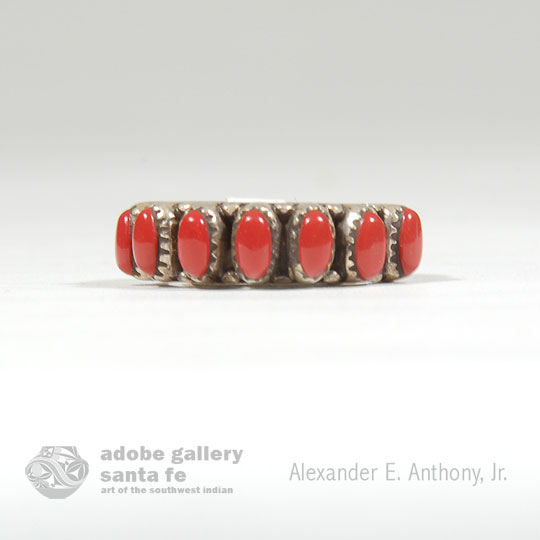 This Sterling Silver and Coral Band Style Ring has seven beautiful blood red coral cabs mounted in serrated silver bezels attached to a ¼" wide silver band. A sea shell design overlays the silver band at the ends of the row of coral cabs. The band is stamped 925, a notation that the silver is sterling.
This Sterling Silver and Coral Band Style Ring has seven beautiful blood red coral cabs mounted in serrated silver bezels attached to a ¼" wide silver band. A sea shell design overlays the silver band at the ends of the row of coral cabs. The band is stamped 925, a notation that the silver is sterling.
Sterling Silver and Double Turquoise Navajo Ring - C3864.33
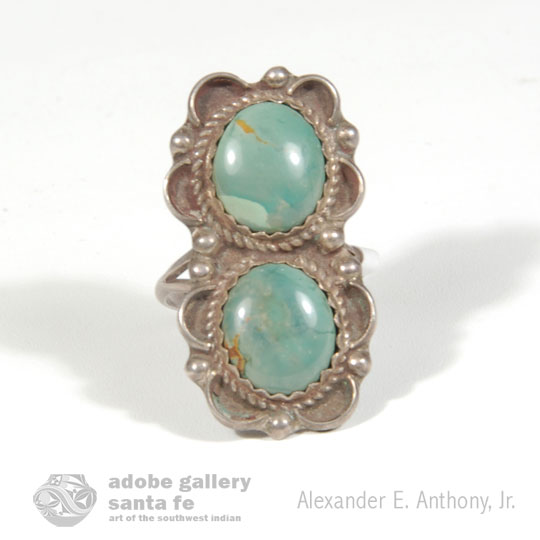 The green turquoise cabs in this Sterling Silver and Double Turquoise Ring have an opalescence like opals. It is as if one could see into the stone, past the face, into its depths. The green stones are beautiful. The silverwork surrounding the pair of turquoise cabs form semicircles on the edges and are then separated by silver dots. Each turquoise cab is surrounded by silver twisted wire.
The green turquoise cabs in this Sterling Silver and Double Turquoise Ring have an opalescence like opals. It is as if one could see into the stone, past the face, into its depths. The green stones are beautiful. The silverwork surrounding the pair of turquoise cabs form semicircles on the edges and are then separated by silver dots. Each turquoise cab is surrounded by silver twisted wire.
Pair of Paintings of Squirrels and Hogan by Beatien Yazz - C3876J-K
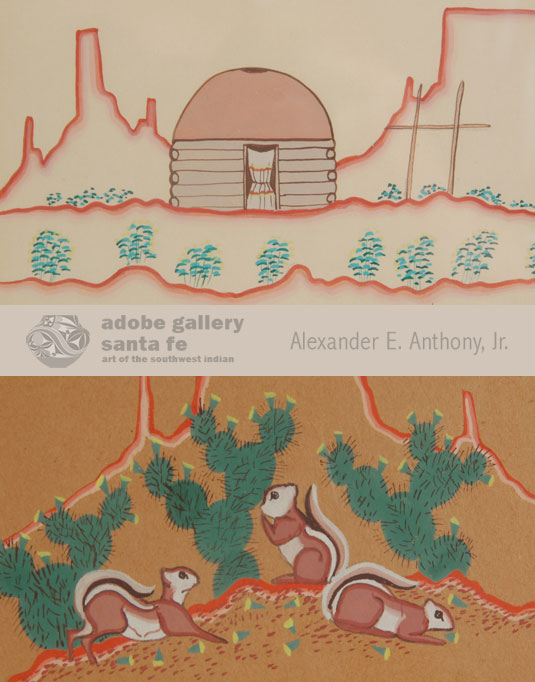 These two paintings are being offered as a pair. They are matted and framed in the same manner and appear to have been paired since they were painted, so it is appropriate to keep them together for the future.
These two paintings are being offered as a pair. They are matted and framed in the same manner and appear to have been paired since they were painted, so it is appropriate to keep them together for the future.
One of the paintings features three squirrels foraging around three cactus plants from which some of the fruit is scattered around the area. In the background is a red-outlined butte, typical of the Navajo Reservation landscape.
Rare Santa Ana Pueblo Polychrome Jar by Lena Garcia - 25943
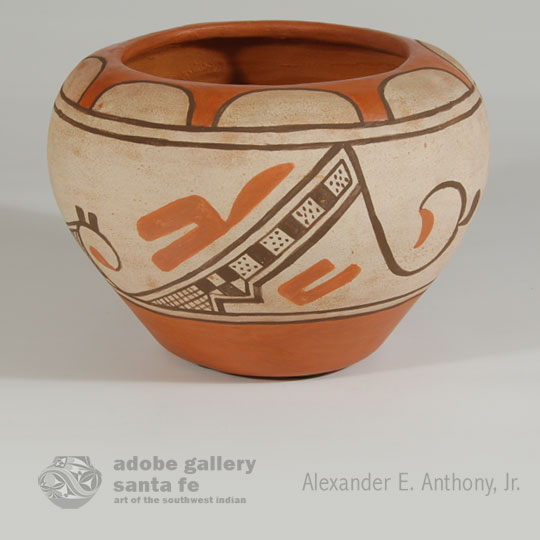 Lena Garcia (1924-?) was one of Eudora Montoya's students in the 1970s. She continued making pottery until 1996. Her niece, Diane Menchego, is currently an active potter, one of only two remaining.
Lena Garcia (1924-?) was one of Eudora Montoya's students in the 1970s. She continued making pottery until 1996. Her niece, Diane Menchego, is currently an active potter, one of only two remaining.
This small, Rare Santa Ana Pueblo Polychrome Jar by Lena Garcia is one with the smoothest and finest surface finish of many examined from Santa Ana. Because the potters use sand as temper mixed in the clay, the surface of pottery from Santa Ana is usually grainy, but Garcia seems to have overcome that flaw with her pottery. The design incorporates traditional designs from Santa Ana historic pottery.
Historic Santa Ana Pueblo - Tamaya Bowl - 25184
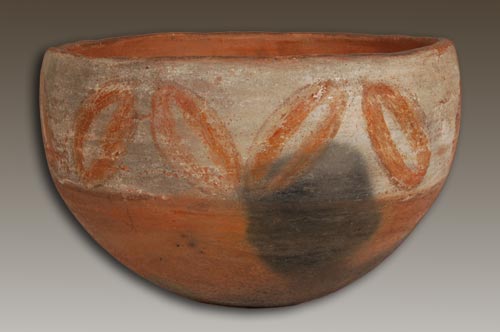 This Santa Ana Pueblo bowl is a late 19th century piece. The bottom is flat and the rim has a slight inward flexure. The design is a continuous chain of alternating tilting left and right oval elements painted in red, outlined in black and painted on a white slip. A black line encircles the bowl at the bottom of the white slip and separates it from the red underbody slip that is stone polished. Beautiful fire clouds appear mostly on the red underbody, and occasionally on the sidewalls.
This Santa Ana Pueblo bowl is a late 19th century piece. The bottom is flat and the rim has a slight inward flexure. The design is a continuous chain of alternating tilting left and right oval elements painted in red, outlined in black and painted on a white slip. A black line encircles the bowl at the bottom of the white slip and separates it from the red underbody slip that is stone polished. Beautiful fire clouds appear mostly on the red underbody, and occasionally on the sidewalls.
Collection of 20 Miniature Southwest Indian Papago Baskets - C3353
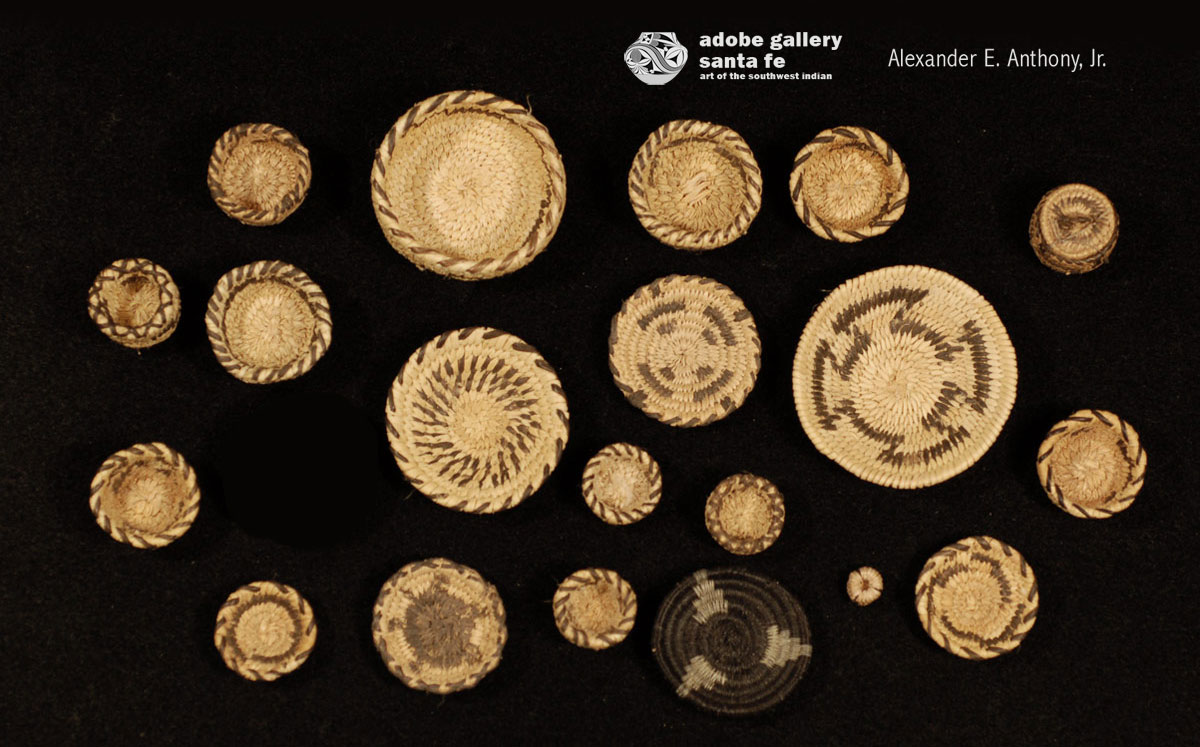 This collection of miniature baskets was assembled in the 1960s by a client from the Midwest. The collection represents weavers from Tohono O'odham, Akimel O'odham and Pomo tribes. The collection is being offered as a group for the stated price, which, it has been determined, is well below market value.
This collection of miniature baskets was assembled in the 1960s by a client from the Midwest. The collection represents weavers from Tohono O'odham, Akimel O'odham and Pomo tribes. The collection is being offered as a group for the stated price, which, it has been determined, is well below market value.
Quincy Tahoma Painting of Diné Fire Dance of the Mountain Chant - C3878
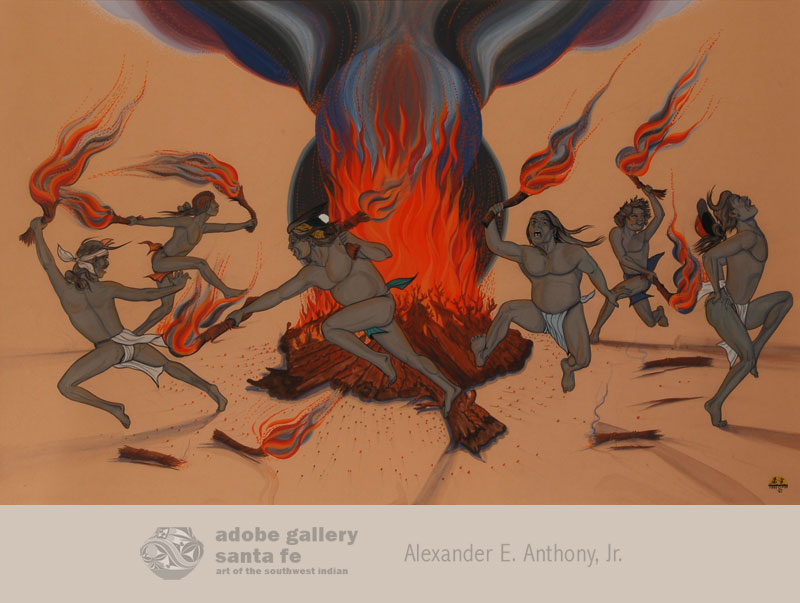 The Navajo Fire Dance is a public dance performed at the end of the nine-day Mountain Chant. To start the dance, many young men drag great trees for a central fire, which rapidly turns into fierce flaring, crackling, and roaring heat. When it becomes its hottest, suddenly the loud burring call of the fire-dancers fills the air.
The Navajo Fire Dance is a public dance performed at the end of the nine-day Mountain Chant. To start the dance, many young men drag great trees for a central fire, which rapidly turns into fierce flaring, crackling, and roaring heat. When it becomes its hottest, suddenly the loud burring call of the fire-dancers fills the air.
Quincy Tahoma (1917-1956) Water Edge - Near Water has presented the Fire Dance in a most accurate manner as performed by the group of young men, always young men, because of the demanding energy required. To appreciate the intensity of the Fire Dance, we rely on a description by Dr. Washington Matthews who attended such a dance in the 19th century.
Pair of Black Figural Candlesticks with Twisted Stems by Legoria Tafoya - 25942
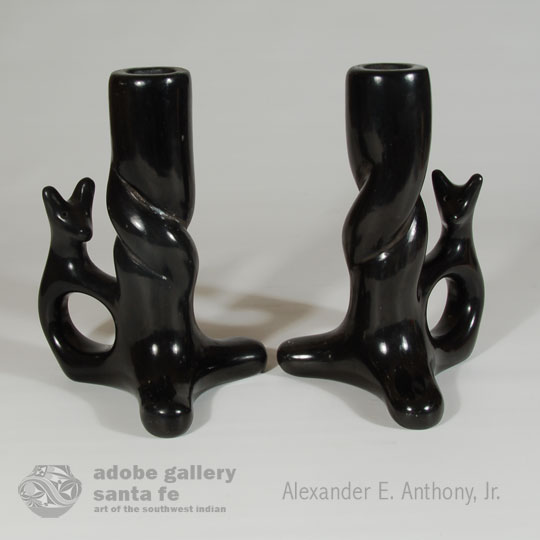 Legoria Tafoya, Pablita Velarde, and Jane Baca were sisters. Legoria was the oldest and Pablita the youngest. Legoria devoted her career to making traditional black pottery in the Santa Clara Pueblo style, and so did her sister Jane Baca. Pablita Velarde (Golden Dawn) is the one who chose to be an easel painter. All three sisters were exhibited at Enchanted Mesa Gallery in Albuquerque, owned by Fred and Margarete Chase.
Legoria Tafoya, Pablita Velarde, and Jane Baca were sisters. Legoria was the oldest and Pablita the youngest. Legoria devoted her career to making traditional black pottery in the Santa Clara Pueblo style, and so did her sister Jane Baca. Pablita Velarde (Golden Dawn) is the one who chose to be an easel painter. All three sisters were exhibited at Enchanted Mesa Gallery in Albuquerque, owned by Fred and Margarete Chase.
Each of this pair of black candlesticks starts with a triangular pedestal from which the stem twists upward to the top. A handle in the shape of a dog or similar animal protrudes on one side. The candlestick pair is probably a late creation by Legoria as they are spectacularly constructed and burnished with a beautiful black finish from firing. They are not the work of a beginner but reflect the hands of an experienced potter.
Single Figure of a San Ildefonso Buffalo Hunter in Full Regalia by Soqween - C3876F
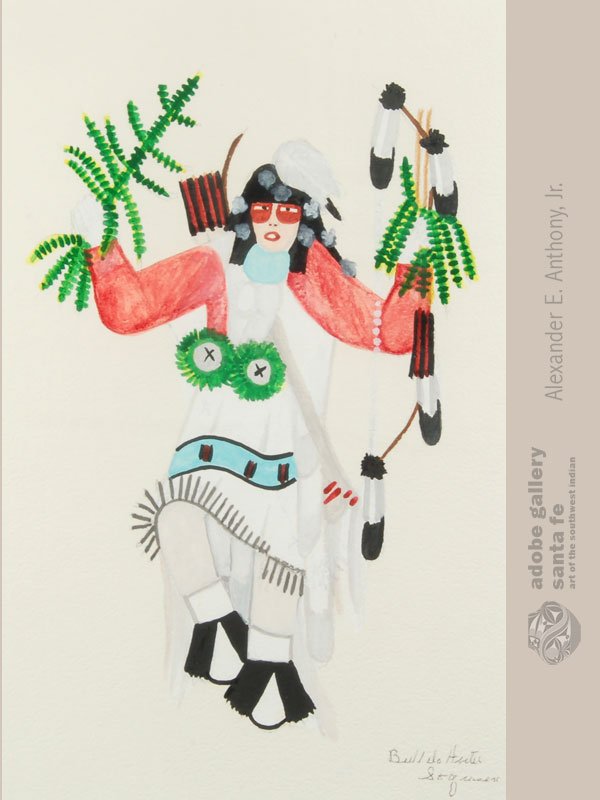 José Encarnacion Peña (1902-1979) Soqween - So Kwa A Weh (Frost on the Mountain) was among the many painters at San Ildefonso Pueblo working in the 1920s: namely, Tonita Peña, Richard Martínez, Luís Gonzales, Abel Sánchez, and Romando Vigil.
José Encarnacion Peña (1902-1979) Soqween - So Kwa A Weh (Frost on the Mountain) was among the many painters at San Ildefonso Pueblo working in the 1920s: namely, Tonita Peña, Richard Martínez, Luís Gonzales, Abel Sánchez, and Romando Vigil.
This painting by Peña depicts a Single Figure of a San Ildefonso Buffalo Hunter in Full Regalia-a participant in the Buffalo Dance. His color usage is subdued and the details are very soft.
Santa Clara Pueblo Black Pottery Horse Single Bookend by Maria Naranjo - C3675E
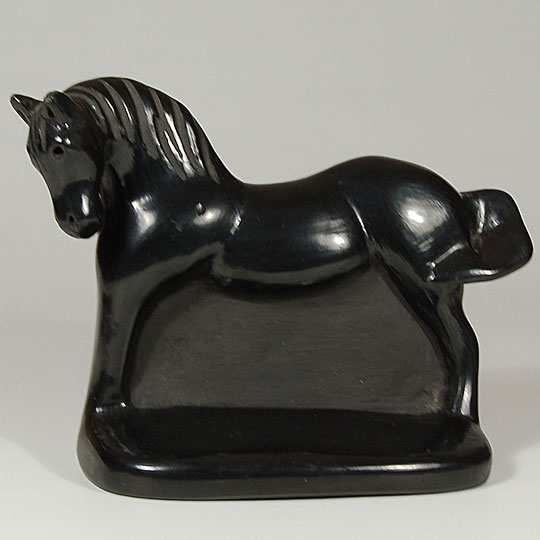 I am stating that this black horse single bookend was made by Maria I. Naranjo of Santa Clara Pueblo, even though it is not signed as such. She is known to use the name Margarita Naranjo and this horse is signed this way. I am also basing this on my experience with her and the special items she made for me years ago. I showed her a photo of a three-piece pottery train that is in the Museum of New Mexico and asked her to make one for me, which she did. When I asked if she would make another one, she refused, without comment.
I am stating that this black horse single bookend was made by Maria I. Naranjo of Santa Clara Pueblo, even though it is not signed as such. She is known to use the name Margarita Naranjo and this horse is signed this way. I am also basing this on my experience with her and the special items she made for me years ago. I showed her a photo of a three-piece pottery train that is in the Museum of New Mexico and asked her to make one for me, which she did. When I asked if she would make another one, she refused, without comment.
Acoma Pueblo Polychrome Swirl Design Seed Jar by Dorothy Torivio - 25940
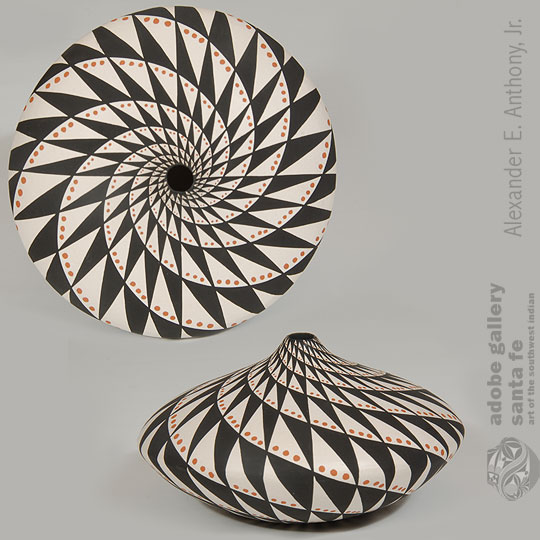 Dorothy Torivio was the most progressive artisan at Acoma Pueblo as early as the 1980s. She was born at Acoma Pueblo and is renowned for her innovative work in exaggerated seed-pot forms in large and miniature sizes. She painted her hand-coiled and outdoor-fired pots with black and white or polychrome patterns of staggering intricacy, painted fresh, and with beautiful precision.
Dorothy Torivio was the most progressive artisan at Acoma Pueblo as early as the 1980s. She was born at Acoma Pueblo and is renowned for her innovative work in exaggerated seed-pot forms in large and miniature sizes. She painted her hand-coiled and outdoor-fired pots with black and white or polychrome patterns of staggering intricacy, painted fresh, and with beautiful precision.
Hopi Unusual Polacca Polychrome Jar by Nampeyo of Hano - C3869B
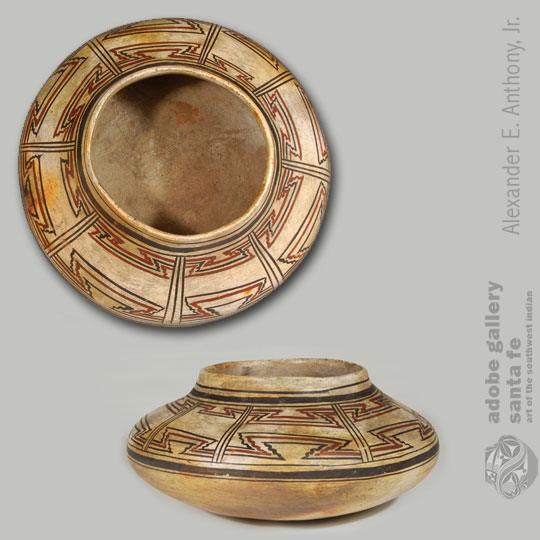 Nampeyo of Hano, in the late 1800s, secured clay from the area and made pottery on which she applied designs she witnessed from earlier Polacca Polychrome shards. She used those prehistoric designs as inspiration for her new creations.
Nampeyo of Hano, in the late 1800s, secured clay from the area and made pottery on which she applied designs she witnessed from earlier Polacca Polychrome shards. She used those prehistoric designs as inspiration for her new creations.
This jar is of a vessel shape closely allied with Nampeyo. The rim of the jar rolls outward with just a slight curve, almost indistinguishable. The design is unique. It does not appear to be documented in any published collection so it is probably a design developed by Nampeyo from another design from which she improvised.
Original Painting of a Young "Butterfly" Female Dancer by Terri Moyers - 24263
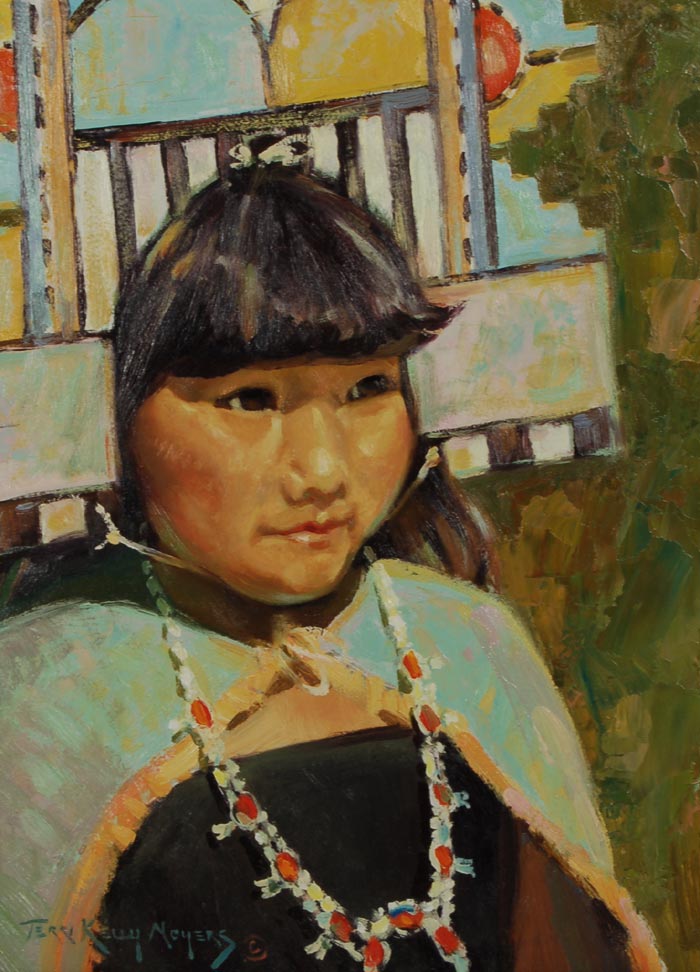 The artist of this painting, Terri Kelly Moyers, and her husband John Moyers, are famous Southwest artists of landscapes and people. Both are multiple award winners. The young Hopi girl who modeled for this painting was the 1st Place winner in the Traditional Dress Contest at Santa Fe Indian Market in 1990, the year this painting was executed. The painting is in original excellent condition.
The artist of this painting, Terri Kelly Moyers, and her husband John Moyers, are famous Southwest artists of landscapes and people. Both are multiple award winners. The young Hopi girl who modeled for this painting was the 1st Place winner in the Traditional Dress Contest at Santa Fe Indian Market in 1990, the year this painting was executed. The painting is in original excellent condition.
San Ildefonso Pueblo Interior Design Dough Bowl by Martina Vigil and Florentino Montoya - C3787B
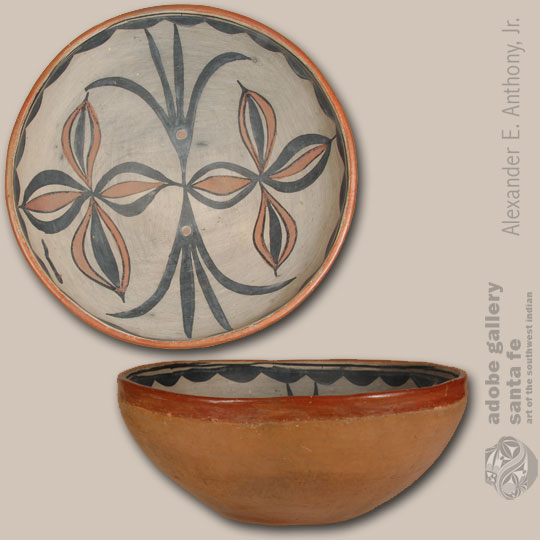 Martina and Florentino would make the little San Ildefonso Pueblo the center of innovative ceramic art. It would be several decades later before Maria and Julian enhanced that reputation. Thanks to extensive research by Jonathan Batkin, the importance of Toña Peña and Martina and Florentino became public knowledge. Their pottery ranks at the top of modern pueblo pottery.
Martina and Florentino would make the little San Ildefonso Pueblo the center of innovative ceramic art. It would be several decades later before Maria and Julian enhanced that reputation. Thanks to extensive research by Jonathan Batkin, the importance of Toña Peña and Martina and Florentino became public knowledge. Their pottery ranks at the top of modern pueblo pottery.
In adopting Cochiti slip around 1910, Martina and Florentino experimented, settling on using a lighter application of the slip than their Keresan potters, who favored a thick application. The result is a grayish undertone. Florentino's designs often display a shift from red to black in alternating patterns on the same element. The floral petals on the design of this bowl are a good example of such. He alternated the exterior petals from solid black to a solid orange outlined in black. The inner petals of the flowers alternate in the same manner.


